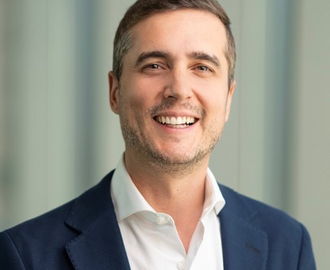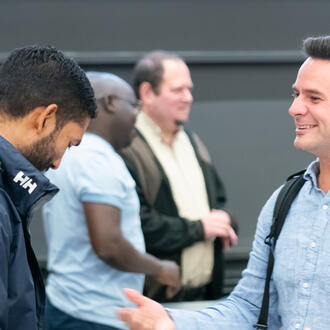Supply Chain
Recalibrating for Disruption— Bulletins from Strategic Points in the Global Supply Chain
MIT Sloan Fellows alumni around the globe discuss the vulnerabilities of the supply chain—from end to end.
Meet the pundits

Aayush Giri, SF ’16
-
LocationDenmark

Morten Bay Jensen, SF ’11
-
LocationAustria

Venkat Maroju, SF ’07
-
LocationIndia

Aline Oliveira Pezente, SF ’18
-
LocationBrazil
Let’s kick off the discussion by going back in time a bit. What stress points were you seeing in supply chains before the pandemic?
Venkat Maroju: I was in Uganda in the spring of 2021 to help the national government and the World Bank tackle agriculture supply-chain problems that existed before the rise of COVID-19. Farmers throughout the developing world are part of a long and complex global value chain that is rife with distrust. We all want to know more about who is producing our food and how. Does it involve deforestation, slave labor, unfair wages, and so on? At the same time, the agricultural sector has one of the least digitized supply chains in the world. This not only hurts the consumer, it also greatly disadvantages small- and medium-sized farmers. For coffee growers in Uganda, for example, lack of transparency helps perpetuate a system in which they receive only 7 percent of the value of their crops on average. It’s not a sustainable model for either producers or consumers.
Aline Oliveira Pezente: Prior to the pandemic, agriculture supply chain issues in Brazil were similar to those in the rest of the developing world—closed and stubbornly analog. Although roughly five million farmers in Brazil plant and grow nearly 65 percent of the country’s major proteins and carbohydrates, just a few thousand buyers control the flow of those commodities. The country also has suffered from an historical super-cycle of bad weather that threw consumption and production out of balance. That cycle created severe credit problems for small and medium-sized farmers. Low yields in one year led to missed loan payments by farmers as well as scarcity and high prices for consumers in the next season. Unfortunately, lenders seized many assets before farmers could benefit from the following year’s price increases, and productivity took another hit.
Morten Bay Jensen: Although we aren’t as vulnerable to unexpected weather patterns as farmers, we can be caught short by atypical meteorological cycles in the apparel industry. And the high-quality footwear sector is a particularly challenging subset of the apparel industry. The overall capacity of our supply chain is relatively inflexible, which makes it very difficult to react quickly to seasonal fluctuations in demand. When a warmer than normal summer boosts consumers’ desire for sandals, for example, we aren’t able to accelerate our supply chain quickly enough to capitalize on higher-than-usual demand. Theoretically, we could scale up production with temporary relationships, but that approach doesn’t align with our company values or quality standards. Another problem is that historically we’ve had a distant relationship with consumers. What we know about their needs comes to us second or third hand through stores and retail chain representatives, which limits our ability to capitalize on emerging trends.
Aayush Giri: I represent a completely different segment of the supply chain—transport. Since I took up my role as head of Stena Bulk A/S, my focus has been on the tanker side of the global maritime supply chain. The ships in my part of the company act essentially as conveyor belts for fuel and chemicals between the world’s major ports. Prior to the pandemic, disruptions could occur for a variety of reasons, from lapses in production to extreme weather events. Taken as a whole, however, ocean-going transport has been a relatively stable and efficient means of moving large quantities of product around the globe. One of our chief concerns was price and making sure that we remained cost-competitive through cycles of higher and lower market rates. At the same time, we were keenly aware of the need to invest in the next generation of transport vessels. Few people realize that core tanker technologies have been relatively static for the last 100 years—which makes sense given that it takes two to three years to build a ship that you expect to be on the seas for 30.
How was your business disrupted by the pandemic, and how did you adapt?
Aline Oliveira Pezente: For our projects in Brazil, COVID-19 wasn’t as disruptive as it might have been. I’d spent the previous year driving around the country to meet with farmers, hear their concerns, and understand their operations. When lockdowns and travel restrictions occurred, I was able to take those relationships online through social media. This fit with a larger pattern that’s working to everyone’s advantage—a generational shift in the agriculture sector from the key players being in their mid-fifties toward people in their forties. This younger generation is much more enthusiastic about digitizing, and the pandemic added urgency to that receptiveness. The fact that Indigo had off-the-shelf technologies to address the most complex and risk-laden aspects of the sector created multiple opportunities—to modernize supply chains, certainly, but also to tackle socioeconomic imbalances and climate change.
Aayush Giri: One challenge that COVID-19 threw into high relief for us, as well as the shipping industry more broadly, was the life and livelihood of the professional seafarer. They were an unnoticed and underappreciated segment of the supply-chain workforce to begin with, and the extraordinary circumstances of the pandemic reinforced just how difficult a life at sea can be. On top of the usual challenges of working in an open-ocean environment, the pandemic left many crew members unable to complete their voyages. They were stuck onboard ships for months beyond their contracted obligations. In some cases, destination ports refused permission to dock or come ashore. In others, crews were able to deliver their cargos but could not fly home because of pandemic-driven limitations on commercial air travel. At Stena, we already were devoting significant resources toward recruiting, training, and supporting the next generation of crew members, and the impact of COVID-19 across our sector has made those initiatives all the more important.
Morten Bay Jensen: We’d already started working to significantly increase our online sales when COVID-19 forced our traditional brick-and-mortar partners to close. Although the massive shift of consumers to online shopping could have been 100 percent positive for us, it didn’t exactly start out that way. The “pure” players in online commerce such as Amazon shifted their strategies beginning in March 2020 to prioritize home essentials that consumers were frantic to buy. Apparel (including footwear), textiles, and other nonessential goods were deprioritized. Fortunately, our own web presence was growing and the European-based site Zalando.com—which was gaining market share—continued to be a strong sales conduit for us. On the wholly negative side, we temporarily lost most of our longtime manufacturing partners (14 of 16 were forced to close down for varying periods of time). In addition, shipping times increased by 20 percent and delivery reliability plummeted from the 80–90 percent range to around 40 percent. We braced ourselves for what we expected to be a 30 percent loss in annual revenue, but the drop was only 12 percent. It turned out that the actions businesses and governments took to keep paychecks flowing kept individual purchasing power from dropping off a cliff.
Venkat Maroju: In the short term, we had to suspend travel for a team headed to Africa. Although the continent was reporting very low infection rates, I could not ask anyone to risk exposure. I ended up going myself in early 2021, and what I found was an even greater enthusiasm among farmers for our digital solution. Because COVID-19 restrictions prevented farmers from bringing their products to market, their awareness of supply-chain vulnerabilities sharpened dramatically. They became more open to what for many was a big shift—using our electronic market to connect with customers they no longer could or needed to meet face-to-face. The fact that we’re enabling a greater level of transparency also helps. It will broaden opportunities for export, increase customer loyalty, and make year-to-year income more predictable. For our part, we accelerated our development of digital solutions so that our partners could participate in those virtual markets as soon as possible.
What potential do you see on the horizon for supply-chain transformation?
Morten Bay Jensen: I see at least three significant developments for us in the post-COVID-19 world. We’re understanding more deeply how internal transparency in our supply chains is essential for every dimension of our business. If we don’t know how our customers are doing—retail partners and end consumers—our forecasting is less reliable and manufacturing less efficient. Our information gathering must be more intentional and less scattered. Digital tools will be key to that effort. Improved data gathering will enable our product development to be more focused. I can foresee a future in which we have far fewer product lines with greater flexibility to ramp up manufacturing in anticipation of greater demand. We also will be intensifying automation and customization—the two go hand-in-hand for us. We already are using 3D printing to make prototypes, which speeds the process of creating and modifying new and existing products. It also future-proofs us to a certain extent when it comes to pandemic-type disruptions on the labor side of our supply chain.
Venkat Maroju: Two lessons have been reinforced for me as a result of this latest global health crisis—not new thoughts but of heightened importance. First, our digital supply-chain tools equip users with important capabilities that add significant value to their activities, but only if the key players engage with good intentions. If governments and business interests are resistant to increased transparency and sensible regulation, we can’t help them. The second lesson, which is an important counterpoint to the first, is that we see an increasing push for democratization. Consumers and producers are understanding supply-chain inequities in a new light and are exerting meaningful pressure on companies. They are demanding that businesses try harder to do the right thing, and many corporations—Cargill and Nestlé, for example—are taking up the challenge. Not only will this increase fairness throughout the supply chain, it will dramatically increase the amount of data we can draw on to inform planting, harvesting, and pricing decisions.
Aayush Giri: We’re at a once-in-a-century inflection point for the global shipping industry. The focus has shifted from building larger and faster ships to making the entire supply chain more resilient and sustainable. The international maritime industry is tight-knit, and we share a strong sense of the need to collaborate on these new objectives. As a sector, we’re committed to cutting our carbon footprint in half by 2050. That will require a breathtaking amount of capital—in the range of $3 trillion USD in the next decade. The good news is that the heightened visibility of global supply chains triggered by the pandemic also increased interest in making those investments. At Stena, we’ve always kept our ears to the ground and been a strong local presence in people’s lives. We take our responsibilities to the communities we serve very seriously, and we will stay at the forefront of the dialogue about how to serve them and the planet better.
Aline Oliveira Pezente: Every major world economy has a blueprint to reduce carbon emissions, and many include strategies related to supply chains and agricultural production. That can only be successful with the right technologies in place. Policies and strategies must—and will—become increasingly data driven, and we must have reliable tools for measuring and verifying that what we’re doing is working. With the plight of small and medium-sized farmers gaining greater visibility, we have the opportunity to implement solutions that make our food supply chain more resilient and more equitable to farmers. Post-COVID-19, we’re intensifying our focus on building community connections, reducing transaction costs, and leveraging crop and climate data to create a new asset class related to sustainability targets. I also expect wider adoption of the new AI-supported approach to farmer credit scores pioneered by Traive, the ag finance startup I cofounded with Fabricio Pezente, SF ’18. The approach includes five activity metrics that give lenders a much more realistic sense of who is a good credit risk. These new models will incentivize smaller, more resilient farm units that can employ four to five family members in typical communities throughout Brazil. Such farms will be key to rebuilding an agriculture sector capable of growing the food we’ll need in the coming decades.


